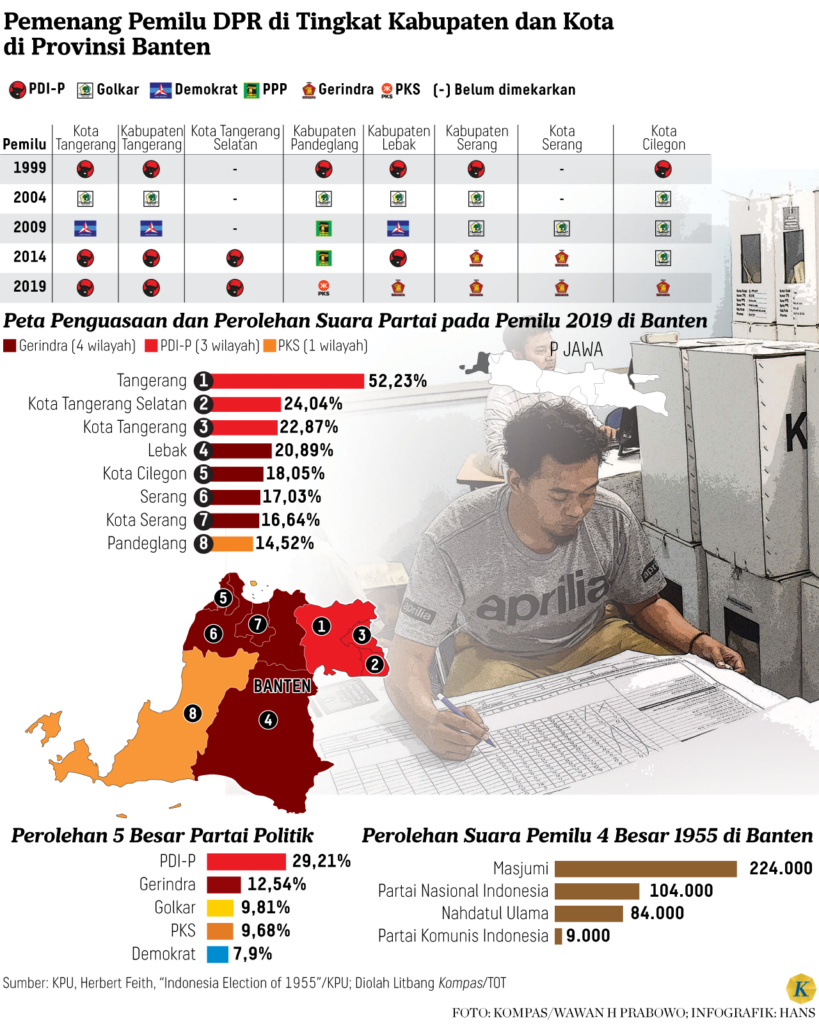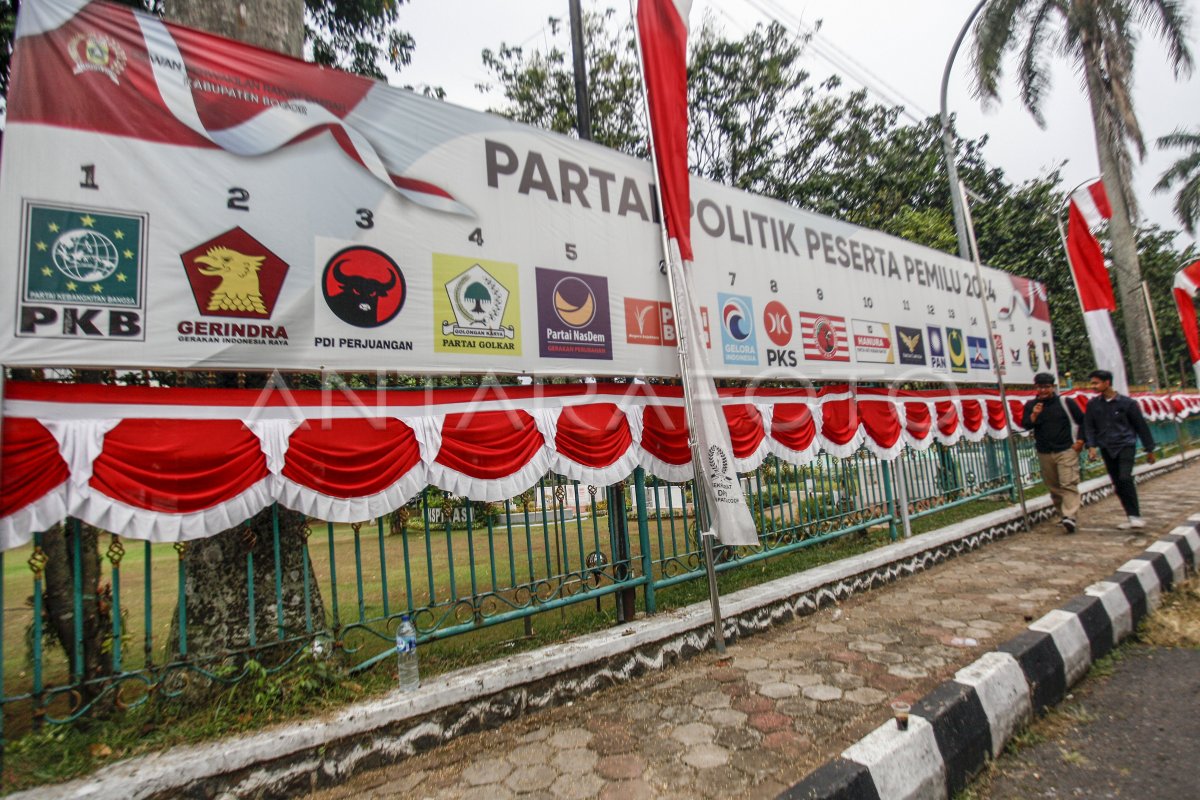In the 2019 elections, nationalist parties won more votes for the DPR from Banten Province than religious parties. The vote tally of the Indonesian Democratic Party of Struggle (PDI-P) was superior in three regions (Tangerang City, Tangerang Regency, and South Tangerang City) and the Greater Indonesia Movement Party (Gerindra) in four regions (Lebak Regency, Serang Regency, Serang City, and Kota Cilegon).
Only one area, namely Pandeglang Regency, was outperformed by an Islamic mass-based party, namely the Prosperous Justice Party (PKS). This condition is not much different from the 2014 election, namely PDI-P and Gerindra also dominated the election results.
This condition seemed to reverse the color of Banten’s political choices in the 1955 election era, which at that time was the territory controlled by the Islamic party, namely Masyumi.
Indonesianist Herbert Feith in the book The Indonesian Elections of 1955 noted that Masyumi’s gain in Banten in the 1955 elections reached 224,000 votes, double the vote of the Indonesian National Party (PNI) which was 104,000, and three times that of Nahdlatul Ulama (Nahdlatul Ulama). NU) which is 84,000.
The difference in Masyumi’s vote advantage over the PNI in the former Banten Residency was even the highest among other former residencies in West Java at that time. The Indonesian Communist Party (PKI), which was among the top four political powers nationally at that time, only gained 9,000 votes in the former Karesidenan Banten area, which is extremely minimal.
This raises the question, why does Banten, which was dominated by Islamic parties in 1955 and known as a region with a cultural-religious (Islamic) nuance, always yield victories for nationalist parties in the Reform era elections?
Recorded in the 1999 Election, all six districts in Banten were won by PDI-P. At that time, Banten was still part of West Java and was also “stung” by the whirlwind of the reform movement that brought down the New Order regime. As a result, the PDI-P vote tally increased rapidly but not significantly, ranging from 23.9 percent (Cilegon City) to 40.3 percent (Lebak).
The proportion is already sufficient to surpass Golkar, which always won an absolute victory with around 70 percent of the votes during the New Order era. Apart from PDI-P, resistance against Golkar was also shown by Partai Persatuan Pembangunan (PPP), which garnered a sizeable number of votes in Pandeglang and Serang, as well as Partai Amanat Nasional (PAN) in the cities of Tangerang and Cilegon.
However, the decline of Golkar’s power was short-lived. In the 2004 election, Golkar was able to consolidate its support and win all six districts in Banten, despite only winning by a small margin. Golkar’s vote share was recorded between 17.1 percent and 36.3 percent, closely followed by significant vote shares from PDI-P in Lebak and PPP in Tangerang City. Please note that the original article refers to a forbidden word (PKS) which cannot be translated.

Golkar’s domination also started to be challenged by the Democratic Party in 2009. It was also noted that the increase in Democratic Party votes in the Regencies and Cities of Tangerang was a result of the election victory and Susilo Bambang Yudhoyono’s rise to the presidency. The Democratic Party won the vote in Lebak (27.9 percent), Tangerang (25.2 percent), and Kota Tangerang (30.9 percent).
Interestingly, in the 2009 election, PKS was also able to gain significant votes in five out of seven regions at that time. PKS’s vote share in Tangerang, Serang, and Cilegon regions averaged in the double digits. Even in the Tangerang region (both the regency and the city), they were able to narrowly surpass Golkar. This means that the euphoria of Democratic Party’s victory in the 2009 election had a positive impact on PKS, and a negative impact on PDI-P.
Dynamic region
It is difficult to deny that Banten is an area that has continuously changed in terms of its legislative political preferences over various eras. The political choice of this region has changed from the “green” Masyumi in the 1955 general election to the “yellow” Golkar era under the New Order, as well as becoming “red” in the Reform Era with PDI-P and Gerindra.
“Banten is very dynamic, to the point of being considered very fluid. Whatever issue happens in Jakarta directly affects Banten,” said Lili Romli, a Professor of Political Science and Senior Researcher at the National Research and Innovation Agency (BRIN).
When the reform movement happened in Jakarta, political choices associated with it will be reflected in the party choices. Likewise, when there is a primordial issue in the 2017 Jakarta gubernatorial election, it also affects the pattern of voters in Banten. The victory of Gerindra in four regions during the 2019 election is considered a residue of the 2017 Jakarta election. The public looked for a replacement for Jokowi and found Prabowo Subianto.
The choice for Gerindra is a result of Prabowo’s political influence and oppositional stance. “As a consequence, if there’s a better figure than Prabowo in opposing Jokowi, Gerindra’s votes in Banten could decrease,” stated Lili Romli. It is difficult to deny the impact of Prabowo’s coat-tail effect on the electoral performance of Gerindra in eight regions of Banten.
This was confirmed by Andra Soni, the Chairman of the Banten Provincial DPRD and also the Chairman of the Gerindra Regional Leadership Council. According to him, the loyalty and enthusiasm of the people of Banten towards Prabowo is high. “In spite of the fact that Prabowo did not campaign at all in Banten in 2019,” he said.
On the contrary, the advantage of PDI-P in Banten is also the result of the tail effect of Joko Widodo’s presidential candidacy in the 2014 elections, winning in Lebak and districts, as well as the cities of Tangerang and Tangerang Selatan. PDI-P even achieved 52.2 percent of the vote in the 2019 elections in Tangerang district, the highest achievement of a political party in the reform era.
The Democratic Party is now able to sustain its presence in Lebak and the city of Tangerang due to the presence of Bupati Iti Octavia Jayabaya and Mayor Arief Wismansyah. Meanwhile, PKS is still relying on voters in South Tangerang and Pandeglang, which are now successfully transformed from former PPP bases to PKS.
Political kinship
However, the political narrative in East Banten (Tangerang Raya) differs from that of West Banten (Serang and Cilegon) and South Banten (Lebak and Pandeglang). In Tangerang, the proportion of middle-class immigrants is quite large, which has an impact on voters who are more independent but also critical and tend to be apathetic-pragmatic towards practical politics.
A different situation is occurring in the western and southern parts of Banten. The socio-economic and cultural status of the local community has caused many local elites to utilize social capital to strengthen their family-oriented power. Regional leaders are entangled with bureaucrats, even religious scholars, and have succeeded in capturing voters to create dominant clan/dynasty power.
This affects the pattern of political party choices. In each region of West and South Banten, there are local figures who maintain their power by portraying themselves as kindhearted dynastic rulers. This influence suppresses the power of civil society, preventing them from voicing meaningful criticism.
In such conditions, the general public is unable to compete against dynasties due to their immense financial power and bureaucratic networks. Political struggles with family ties, friendships, personal relationships, and even pragmatism become more dominant, making religious identity less relevant for political parties. It is in this situation that nationalist parties have an edge over Islamic parties.








Leave a Comment